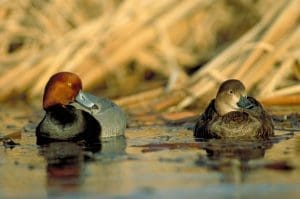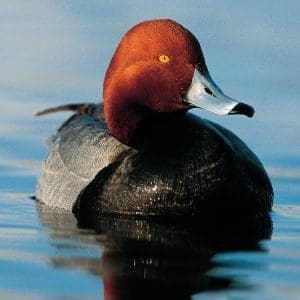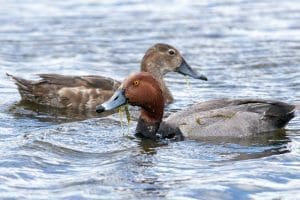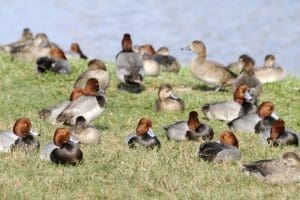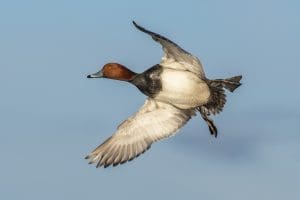Did you know
Redhead ducks are medium-sized diving ducks. They have dark eyes circled by a white eye-ring and grey-ish blue bill. Their grey wings have a light grey band, which extends to their primaries.
Common name: Redhead
Scientific name: Aythya Americana
Diet: Omnivorous
Average life span: 1-3 years
Length: 42-54 cm
Weight: 630-1500 g
Food & Habitat
Redhead ducks inhabit seasonal and semi-permanent wetlands, natural lakes and reservoirs. They prefer deep water wetlands for breeding and brood rearing. Winters in shallow coastal waters with abundant sea grasses.
Redheads feed by diving, gleaning from the surface, or dabbling just below the surface. They eat seeds, buds, and tubers of submergent aquatic plants, as well as larvae, eggs, snails, and other aquatic invertebrates.
Breeding & Population
They breed in high concentrations in the prairie pothole region, along the shores of Ontario’s Great Lakes and the St. Lawrence River in Quebec and on the island river deltas of the boreal forest. Pair bonds are initiated in late winter, increase during spring migration and peak in late April. Late-nesting and prefers to nest over water in bulrush, cattails, or sedges. Incubation is 28 days and ducklings fly at 60 days.
Migration
Redheads winter mainly in the Gulf of Mexico, but can also be found along the Pacific coasts of Mexico and the United States, and along the Atlantic coast from Chesapeake Bay to North Carolina.
Interesting facts
- Redhead ducks are exclusively North American ducks, found nowhere else on earth.
- The redhead flight pattern is erratic and fast.
- The redhead has the greatest propensity of all ducks to carry out nest parasitism, in which the female redhead will push other females off their nests, then leave her eggs for the original hens to care for. Canvasbacks and other redheads are primary targets.
- The male courtship call resembles a catlike “meow” or “purr,” while the female’s call is a typical “quack.”

